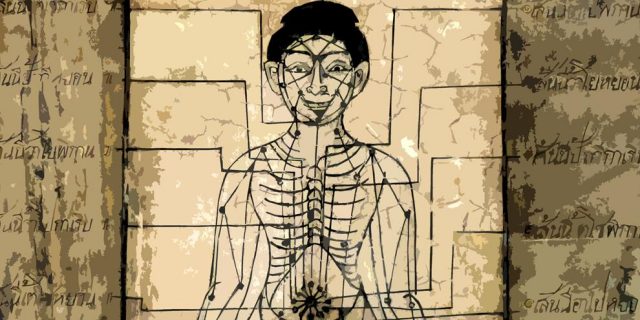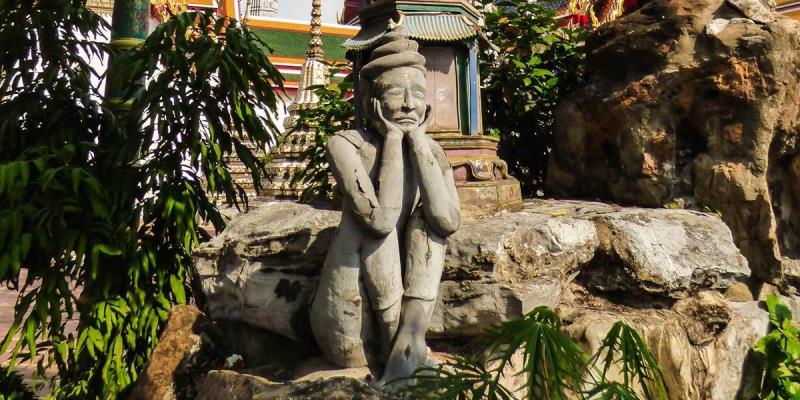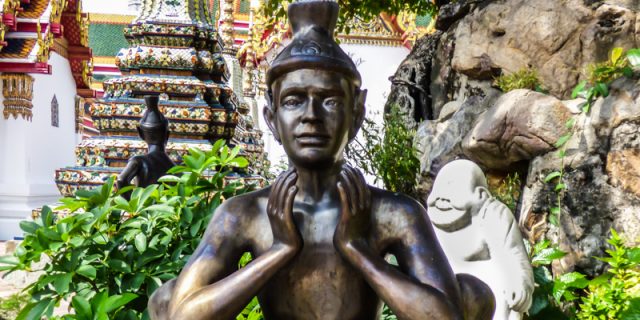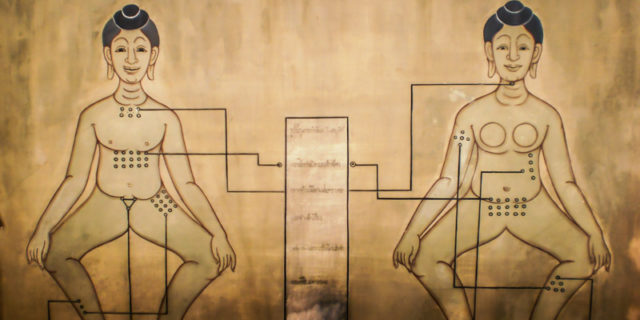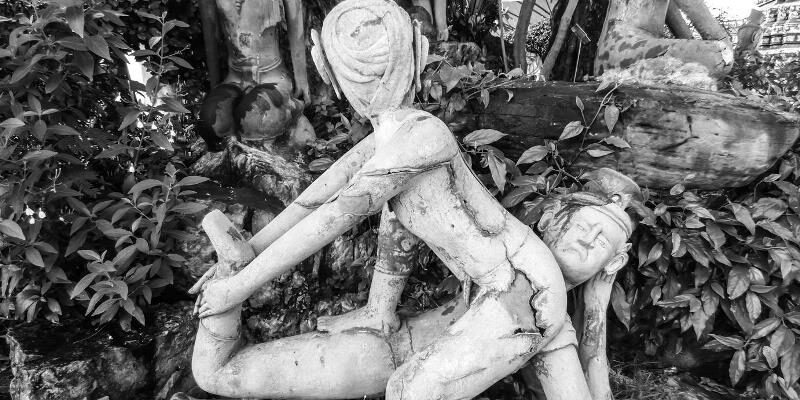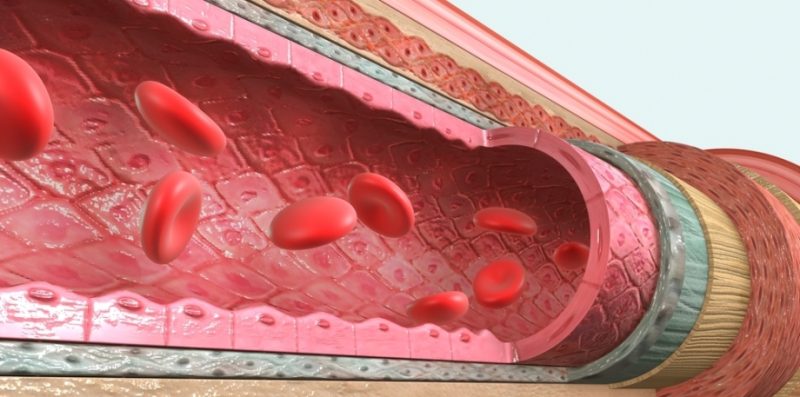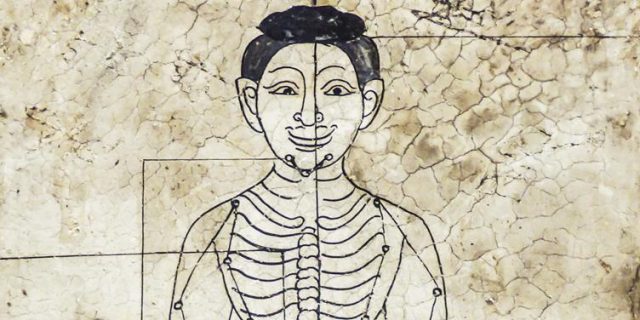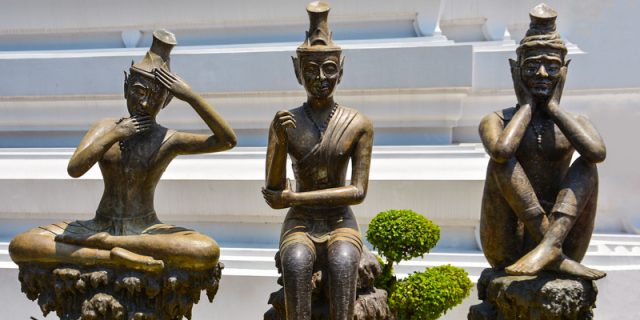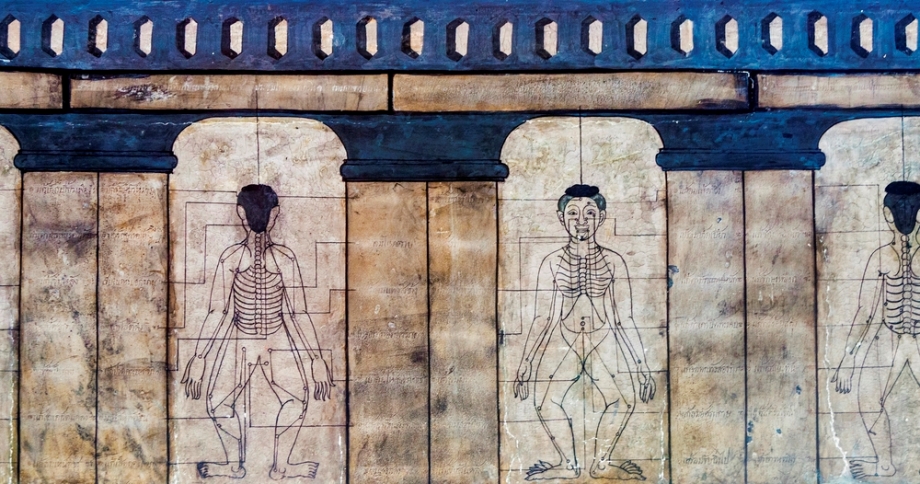
In this post, we’ll explain why the same Sip Sen Energy Lines often have different spellings or even completely different names.
You’ve probably already noticed that many Thai phrases, names and terms may be written in different formats in the Romance alphabet (or Latin alphabet) depending on, well, depending on the way things sound phonetically and who writes it down. Sometimes, this can be quite frustrating when being in Thailand, say, especially annoying with street names.
Phonetic Translations of the Thai Script

But to give an example, the Thai phrase “ท่าฤาษีดัดตน” (freely translated meaning “self-stretching exercises of the hermit”) sounds and may be written as Reusi Dat Ton, Rusie Datton, Ruesri Dat Ton, Rishi Dutton, Rue See Dat Ton, or even Lucie Daton or Lucy Dutton, just to give a few common translations.
Or, “นวดแผนโบราณ” (meaning “ancient Thai style massage”) which sounds and is written as Nuad Phaen Boran, Nuat Phaen Bohran or Nwd Fhan Boraṇ.
The same goes for the Thai Sen Sib Energy Lines (also addressed as Sen Sip, Sib Sen, or Sen Prathan Sib). Sen Ittha, for instance, can be found written as Itha, Itta, Ida, or Eeda, and Sen Kalathari as Kalatari, Kalatharee, or Galadhari. Just to give you the idea.
Origin of Sen Sib Line Names
Liberal phonetic translations can of course give problems with understanding the Thai Traditional Medicine (and thus Thai Massage) heritage, but another additional issue, which is the case with the Sen Energy lines, is that some of the Sen Sib (Ten Sen) actually have totally different names, that is, synonyms.
The reasons to this are that knowledge of the Sen Sib comes from different Thai scriptural sources and in those sources the Sen Sib are (partly) addressed by different names (leaving Thai accents, dialects, and regional differences out of the equation).
The most important scriptural records are:
- The Tamla Loke Nitan Text (Tamra Rok Nithan Khamchan 11 i.e. Textbook of Etiology) from the reign of King Rama II (reign: 1809-1824 CE).
- The stone tablets inscriptions with graphics i.e. pictures at the Wat Pho temple (Wat Phra Chetuphon) in Bangkok, which were recorded during the reign of King Rama III (reign: 1824 – 1851 CE), also called the Pharb Phaen Nuad or Massage Illustrations. The first 18 engravings are about the ten primary Energy Lines.
- The Royal Traditional Thai Medicine Text (Section Massage Patterns or Phaen Nuad 1 and 2) written in 1870 during the reign of King Rama V (reign: 1868 – 1910 CE), called the Tamra Vechasart Chabab Luang.
Sib Sen Line Synonyms
Now, let’s take a look at the Thai Sib Sen name variations we can encounter:
SEN SUMANA
Sen Sumana can also be found as Sumna, Summana, Susummana, or Sushumna.
SEN ITTHA
Sen Ittha can be found as Itha, Itta, Ida, or Eeda.
SEN PINGKHALA
Sen Pingkhala can be found as Pingla, Pingkla, Pingkala, or Pingala.
SEN KALATHARI
Sen Kalathari is found as Kaniataree, Kanlataree, Kantaree, or Galadhari.
SEN LAWUSANG
Sen Lawusang is also labeled as Lawusank, but also has a variety of other names such as Kuchung, Urang, Pusumpawang, Chanthapusang, Chandabhusang, Sampasaso, Jantapusank or Junthapusunk.
SEN ULANGKA
Sen Ulangka is also written as Ulangga, but can be found under completely different labels like Sorawani, Rucham, Rujam, Ruchum, Rusum, and Sukumusama.
SEN SAHATSARANGSI
Sen Sahatsarangsi is also written as Sahadsarangsri and Sahasrangsi, and also has other designations such as Hadsaluedee and Hadsarangsri.
SEN THAWARI
Sen Thawari can be found written as Tawaree, but also as Dwari, Kongjagorn, Tawanjan, and Tawakata.
SEN NANTHAKRAWAT
Sen Nanthakrawat is also written as Nantagrawad, and carries other names like Kangku, Tawatharee, and Sukumang.
Sen Nanthakrawat actually consists of two distinct Energy Lines: Sen Sikhini and Sen Sukhumang.
SEN KHITCHANNA
Sen Khitchanna is also found as Sikkinee, Sikinee, Sikhani, Sikhini, Itaken, Kitcha, Kitchanna, Kish, Sankkinee, and Rattakinee.
Sen Khitchanna consists of two distinct lines depending on the gender which are called Sen Pitakun (or Pittakun) for men, and called Sen Kitcha for women.
Final Thoughts
Well, things can be quite confusing if you aren’t aware of these differences in spelling and naming. Moreover, depending on the Thai Medicine or Thai Massage school, you will generally learn one set of names (and spelling), which can complicate communications with Thai Healing Arts practitioners of other lineages.
In any case, the variety of labels for the Sen Lines again proves this ubiquitous proverb that so accurately describes the Thai people: Same, Same, but Different.








